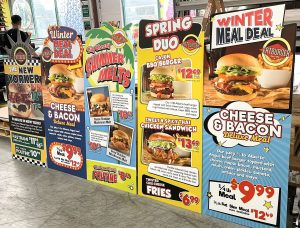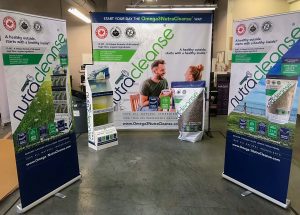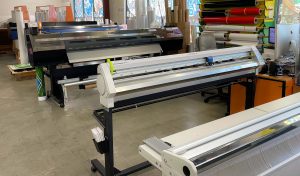
POP signs like these help Fatburger alert its customers to seasonal specials
What types of POP and wayfinding signage are clients generally asking for?
BL: We have produced window, wall, and floor graphics, POP signage, displays, banners, decals, wayfinding signage, and more. Obviously, some stores do not have the same square footage as others, so windows and wall space can become key in displaying their messages.
During COVID, many of our clients had to adapt the way they displayed POP and wayfinding signage. Suddenly, they needed signage in new locations, including on surfaces like wooden tables, drywall, glass, vinyl seats, concrete, and asphalt. This meant we had to seek out materials (vinyls and rigid substrates) that could be used for multiple functions.
What are you aiming for in creating POP or wayfinding signage?
B.L. As with all signage, colour management is crucial to maintaining clients’ branding and corporate identity. One of our client’s corporate colours happens to be a certain green, which is one of the hardest colours to print. Fortunately, our Roland DG TrueVIS VG2-640 has an expanded colour gamut that makes hitting specific greens much easier.
Colour is also the factor that can harmonize the sign with the environment. Inversely, colour can make a sign’s message stand out and be noticed. Of course, any text or graphics on POP and wayfinding signage must be clear and to the point so it can be viewed and understood while pulling into a parking lot or walking through a store.
When we are asked to design signage (rather than printing artwork provided to us by the client), our design team works closely with our production team to ensure the final product is up to our client’s standards. This means understanding what our production capabilities and limitations are, and what materials require special attention during the design process.

Still Creek Press uses careful colour management to produce consistent colours across all its printers and presses.
In addition to the elements of colour and textual clarity, are there any other considerations in developing retail signage that can help turn browsers into buyers?
BL: This is something we are always looking into. These days, people often have their heads down, buried in their phones. We try to take a practical approach to this challenge. How can we utilize floor graphics to catch their attention? Or wall murals? Sure, everyone does it… but how can we make our graphics stand out from the others? We find it’s a balance between eye-catching design and colour contrasts, clear and concise messaging, and well thought-out, accessible placement of every sign that plays the largest role in converting browsers to buyers.
Do you have retail/wayfinding clients for whom you develop seasonal signage?
BL: We provide seasonal signage for our restaurant clients and others. When we know seasonal signage projects are coming, we can plan our purchases and bulk buy our materials. We use any cost savings to offer our clients more competitive pricing. In this time of COVID, with material costs going up by 10 to 20 per cent, every little bit helps.
Communicating with our client to anticipate these seasonal jobs also helps with staffing as we can better predict our busy periods. Having the proper staffing alleviates the need for overtime and lowers the risk of employee burn-out.

The wide-format production area at Still Creek Press is anchored by three Roland DG printers, including the new TrueVIS VF2-640 64-in. wide-format printer.
What advice would you have for other sign shops that are considering entering the retail and wayfinding signage market?
BL: Do not try to reinvent the wheel. Understand your clients’ needs, know your products, and know what works best for the application. Always keep an open conversation going with your suppliers—they are your lifeline.
In terms of purchasing equipment to enter this market, I would suggest shop owners start small, find versatile machines that can handle multiple applications, and maybe even buy a used machine with little mileage on it. Do not use cheap or low-end inks or materials because you will end up spending more money replacing an inferior product for your client. Ask other shops what machines they have and why they chose them, and stick to your budget.
As cliché as this may sound, it is a very small industry. Seek help from other shops when you need it. Do not burn bridges by irritating your clients because of unforeseen circumstances (like a machine going down). It is better to collaborate with other shop(s) than to compete. In the end, we all come out as winners and with happy clients.
How are things looking for your shop as you start off the year?
BL: We are in a busy time right now, with no signs of that stopping anytime soon. That said, I have a great team and high-quality equipment I can rely on. I love this work. It feels like “arts and crafts” every day.
Ginny Mumm is a freelance consultant for digital inkjet printer/cutter provider Roland DGA. For more information, visit www.rolanddga.com.





